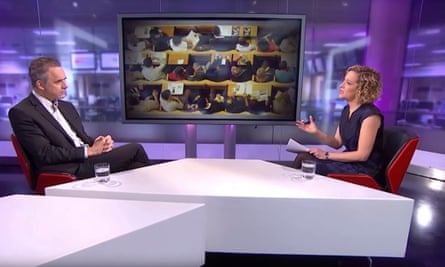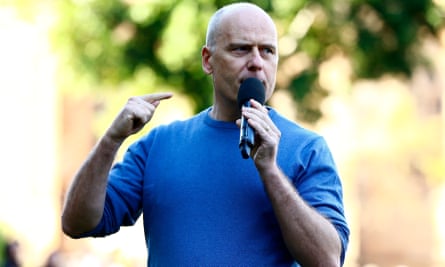‘The gender pay-gap truther”. It is such a distinctive phrase: that neologism of “truther” sitting peculiarly against the throwback of “pay gap”. Something about it tells you immediately that these truthers, like anti-vaxxers, like Russian trollbots, have been around longer than you realise. And you would be right: in polemical YouTube comment sections and Reddit threads, the gender pay gap is already a myth. End of. Simples.
Mike Wendling, the author of Alt-Right: From 4Chan to the White House, says: “You see this from the alt-lite brigade: Milo Yiannopoulos, Ben Shapiro. I’ve rarely seen them bother explaining it to their audiences, who just take the pay-gap ‘myth’ as read.” And that’s despite evidence such as the latest British figures, which show that every industry in the country pays men almost 10% more than women.
There is a purity in this position: from an alt-right perspective, if women “can’t do maths” and “liberals are retarded”, to explain your theory in detail would be beneath your dignity.
Megha Mohan, the BBC’s gender and identity correspondent, says the first time she heard the “myth” debunked in detail was in Stefan Molyneux’s 2015 podcast The Truth About the Gender Pay Gap. Molyneux (who also believes there is a hierarchy of racial intelligence) calls himself a philosopher; this is men’s-rights-speak for “YouTuber”.
If you can make it through the saccharine language (“When you decide to have kids, your time vanishes in a giant airstrike of cuddly cuteness”; “Mother Nature has blessed women with giant feeding bags”), his point is straightforward: the gender pay gap is a myth because it only has one variable – are you a woman or a man and how much do you get paid?
This was echoed in the interview last year between the Canadian pop-psychologist Jordan Peterson and the Channel 4 News journalist, Cathy Newman. As Peterson put it: “Multivariate analysis of the pay gap indicates that it doesn’t exist”. You have to include other variables, Molyneux argued: 55-year-olds make more than 24-year-olds, but is this ageism, or simply a gap of experience and progression? Even taken in good faith, this would be the point of someone who doesn’t understand what you’re trying to measure with a gender pay gap – not any individual woman’s salary, but the structural factors that might be affecting women and their prosperity, and what workplaces and societies might do about them.

Molyneux went on to cite the marriage gap (married women earn less, because they divide their time differently; single women experience no gap); the sectoral gap (women dominate healthcare and education; men dominate architecture and engineering); the interest gap (Molyneux spent a lot of time on computers as a boy, and girls didn’t share that interest); the temperament gap (women have a preference for “working with people rather than tools”).
Peterson, three years after Molyneux, chimed in with very similar points – he was particularly fascinated by the sectoral gap, pointing to Sweden, supposedly a bastion of gender equality, where women outnumber men by 20 to one in nursing, while in engineering, the ratio is the opposite.
He also talks about personality, citing women’s “agreeableness” and the fact that agreeable people tend to get paid less. There is another trait that lacks a descriptor but results in men being more likely than women to apply for jobs for which they are not quite qualified, and women being more likely to apply for jobs for which they are overqualified. Peterson illustrates that concept well: his psychology professorship at Toronto is nowhere near the field of economics, and yet he is very comfortable going worldwide with his take on income distribution and Marxist theory.
At this point in the interview, Cathy Newman’s heckles rose, and she countered that not all women are agreeable, and Peterson agreeably agreed: not all of them, no. But these are trends we are talking about. Of the pay gap, he both started and concluded: “I didn’t deny that it existed; I denied that it existed because of gender.”
This “truthing” is a manoeuvre, and not a particularly sophisticated one: the likes of Peterson have boiled the concept of the pay gap down to a very narrow definition – women think we are paid less because men are sexist, and don’t respect or value us – and then they dispute that definition. Yet the movement for equal pay is much broader than that: let’s say the gap is because we are agreeable, what can we do to create pay structures that don’t just value pushiness? It might be faster to make women more assertive, but in that case, how do you clear the often-demonstrated hurdle that people take assertiveness in women for aggression?
Let’s say the pay gap exists because we take a career break to have children, or want to work part-time afterwards; what can we do, creatively, to make the workplace porous and flexible so that there isn’t a penalty? What if women are not choosing low-paid sectors, but are being excluded from high-paid sectors? Let’s say we do prefer working with people to tools; why should a highly skilled care worker accept that hers is a low-paid sector?
My favourite equal-pay case was the female workers for Birmingham council, who successfully argued that jobs typically done by men – such as working on a bin lorry – were paid bonuses, while typically female ones on the same grade – dinner ladies, lollipop ladies – were not.
It was socially microcosmic, since the women were dealing with one employer, who had a transparent grading system, and they were working in the public sector. It would be very hard to replicate, if you wanted to equalise the take-home pay between a zero-hours carer in Newcastle and a self-employed plumber in Surrey. But it was a great establishment of a very obvious principle: women don’t choose low-paid sectors; sectors occupied by women are persistently undervalued.
At the kernel of the truther movement there are no statistics, only a single idea: women are simply different – softer, more caring, less intellectual, easily distracted by kids and whatnot, biologically programmed, moreover, to tend rather than earn, and society needs us all, but the market doesn’t.
Ultimately, any free-market, fundamentalist view of the world must alight at this very gendered 1950s position, because the alternative is to regulate the market so that it can accommodate the different economic productiveness of different phases of a person’s life. And once you start to regulate markets, you’re not a fundamentalist; you’re a Fabian.

So the genius of the pay-gap myth is that it takes some ancient prejudices about women and their place in the world, which are so hackneyed, familiar, dated and boring that they are now unsayable and recasts them as a modern “controversy”, which the mainstream right then dutifully takes up.
Two weeks ago, I met Kate Andrews, from the rightwing thinktank the Institute of Economic Affairs (IEA). We’re often sofa-pundits together on current affairs shows. I like her; she has this excessive, almost courtly courtesy to me as her senior, practically curtseying, and it amuses me to try to figure out whether it’s sarcastic. Anyway, she had been up all night working on the IEA’s gender pay-gap report. I couldn’t figure out the urgency, and when I read it, could understand it even less.
It talked of myriad problems with gender pay-gap reporting, which seemed to boil down to a misunderstanding of how part-time work is described. (“As women are significantly more likely to work part-time, for which the average salary tends to be lower, the results are almost guaranteed to show that men earn more,” she finds.)
Of course, part-time salaries are lower because fewer hours are worked; but the comparison is median and mean hourly pay; so if there’s a discrepancy, that’s a devaluation of non-full-time work, which is, by the author’s own admission, another gendered pay gap.
The IEA report claims the whole system is discredited because of the time a company reported a pay gap in men’s favour that turned out to be in women’s favour. It complains of cherry picking, after extensive cherry picking of its own. It repeats that sectoral point – of course there is a pay gap among airline workers, because all the women are cabin staff and all the men are pilots – without reflecting on why there are so few female pilots, and whether there has been an erosion in the salary of those cabin staff that isn’t mirrored among pilots.
The IEA’s report is a pumpkinification, turning the dog of an alt-right YouTube narrative into the God of a respectable piece of research.
There is no ready answer to the pay-gap truther movement. Do you ignore it because you can see the cynicism of its skeleton and the frailty of its flesh? Or do you take it on because, like a White Walker, although it is a dead argument, it is on the move? I can’t decide, but I know what its game is.
This article was amended on 26 April to correct the spelling of Megha Mohan’s surname, initially given as Mohen, and to correct a quote mentioning the “alt-right brigade” when the speaker actually said the “alt-lite brigade”.
